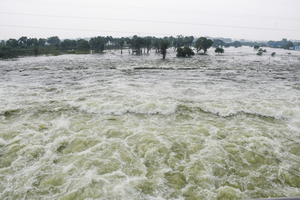Govt, company responses to super-emitter alerts went up tenfold: UN Environment

Nairobi, Oct 22 (IANS) Government and industry responses to UNEP’s more than 3,500 satellite methane alerts climbed from 1 to 12 per cent in the past year. Nevertheless, action must accelerate to minimise global temperature rise and achieve the Global Methane Pledge goal of curbing methane emissions 30 per cent by 2030, a new UN Environment Programme (UNEP) report said on Wednesday.
Historically, emission inventories have underestimated methane emissions, making real-world data a critical tool to track and reduce this potent driver of global warming.
The fifth edition of the UNEP’s International Methane Emissions Observatory (IMEO) publication, ‘An Eye on Methane: From measurement to momentum’, finds that member oil and gas companies of IMEO’s Oil and Gas Methane Partnership 2.0 (OGMP 2.0) are set to track one-third of emissions from global production using real-world measurements.
While government and company responses to alerts from IMEO’s Methane Alert and Response System (MARS) have grown tenfold over the previous year, nearly 90 per cent remain unanswered.
Atmospheric methane continues to be the second-biggest driver of climate change after carbon dioxide, responsible for about one-third of the planet’s warming.
“Reducing methane emissions can quickly bend the curve on global warming, buying more time for long-term decarbonisation efforts, so it is encouraging that data-driven tools are helping the oil and gas industry to report on their emissions and set ambitious mitigation targets,” said Inger Andersen, Executive Director of UNEP.
“However, to keep the Paris Agreement targets within reach, the important progress on reporting must translate into cuts to emissions. Every company should join the Oil and Gas Methane Partnership 2.0, and both governments and operators must respond to satellite alerts — then they must act to reduce emissions,” said Andersen.
The OGMP 2.0 is the world’s global standard for methane emissions measurement and mitigation in the oil and gas sector. It provides the foundation of methane regulations in the world’s largest buying market, the European Union. Over the past five years, OGMP 2.0 membership has more than doubled to 153 companies in the countries, covering 42 per cent of global oil and gas production.
In total, one-third of global oil and gas production reports, or will soon report, emissions at OGMP 2.0’s Gold Standard — meaning emissions are tracked with real-world measurements. This positions a large amount of the global industry to effectively measure — and thus mitigate — emissions.
Of the companies that reported emissions data, 65 companies, representing 17 per cent of global oil and gas production, achieved Gold Standard.
Some 50 companies, representing a further 15 per cent, achieved Gold Standard Pathway — meaning these companies are on track to soon reach Gold Standard reporting. Another 22 companies reported emissions data but did not meet Gold Standard requirements.
–IANS
vg/rad





